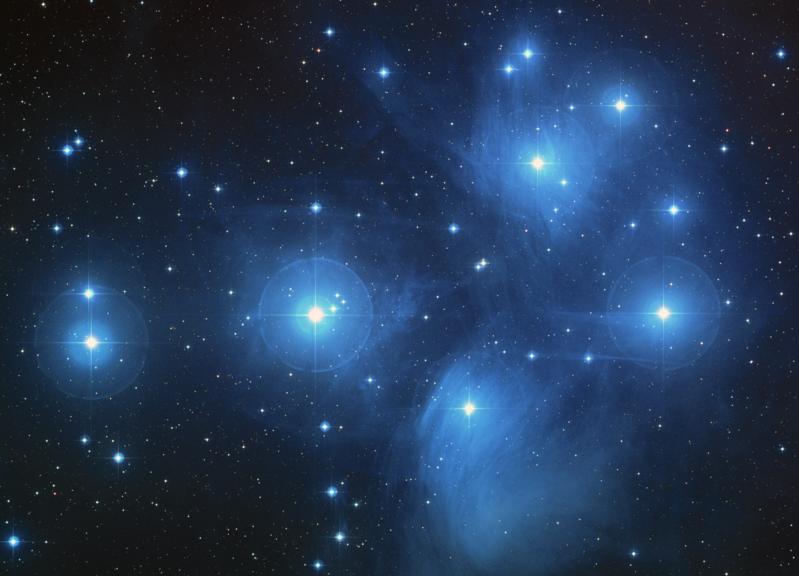







| BOOKS | F. A. Q. | ARTICLES | TALKS | ABOUT KEN | DONATE | BEYOND OUR KEN |
|---|
By Ken Croswell
Published on ScienceNOW (November 19, 2010)

Stellar siblings. With an age that's only 2 percent of the Sun's, the Pleiades cluster is so young that its stars still drift through space together. The Sun and Earth probably once belonged to a similar star cluster, but astronomers have yet to find a single solar sibling.
Credit: NASA/ESA/AURA/Caltech.
Imagine trying to organize a nursery school reunion by visiting retirement homes throughout the country. That's akin to the challenge confronting astronomers who seek the stars born alongside our Sun. Now researchers in Russia say the quest for the Sun's siblings will be even harder because the Milky Way's spiral arms have tossed the stars to and fro.
Although the nebula that spawned the Sun 4.6 billion years ago is long gone, most of the thousand or so stars born in the same cluster should have survived. But like a drop of red dye thrown into the ocean, those stars emerged into an enormous object--a galaxy boasting hundreds of billions of other stars.
Nevertheless, last year astronomer Simon Portegies Zwart of Leiden University in the Netherlands claimed that scientists might be able to find the Sun's siblings. He calculated how the stars dispersed as they revolved around the Galaxy's center and estimated that between 10 and 60 of them should reside within 330 light-years of Earth. At that distance, a Sunlike star is visible through binoculars. Such stars would share the Sun's age, chemical composition, and motion through space--and might give insight into the birth of the solar system.
But astronomer Yury Mishurov of the Southern Federal University in Rostov-on-Don, Russia, was not convinced that the Sun's siblings would be so easy to find. "I thought that [Portegies Zwart's] model was oversimplistic, because he did not take into account the effects of spiral arms," which can fling stars far and wide with their gravity. So Mishurov and astronomer Irina Acharova, also of the Southern Federal University, ran computer simulations that modeled a cluster of stars orbiting the Galaxy's center. The simulations tracked the Sun's siblings as they passed in and out of the Galaxy's spiral arms over 4.6 billion years.
"The stars dispersed in a very broad space," says Mishurov.
In some simulations, the stars spread along a full orbit around the Galactic center. In these cases, just three or four of the thousand stars remained within 330 light-years of Earth. "We cannot say that it is absolutely impossible to find siblings, but it is a very difficult task," says Mishurov, whose work will appear in an upcoming issue of Monthly Notices of the Royal Astronomical Society.
Portegies Zwart says he welcomes the new study. "Even though they seem to be quite critical of my previous work, I'm pretty happy with this publication," he says. "It was the logical next step," because it uses a more sophisticated model of the Galaxy by incorporating its spiral arms. "In the end, of course, what counts is whether or not we will find the solar siblings. I think it's a big mistake to give up looking for them."
Astronomer Gerard Gilmore of the University of Cambridge in the United Kingdom is not so sure. Although he acknowledges the lively interest in the topic, he says the whole search for solar siblings is dubious. Ascertaining that a star has exactly the Sun's age is impossible, he says, and many unrelated stars share its chemical composition. "It's not hard to find a list of stars rather like the Sun, but how you would ever know that a star was your long-lost twin brother is a much harder question to answer."
Ken Croswell is an astronomer and the author of The Lives of Stars.
"A stellar picture of what we know or guess about those distant lights."--Kirkus. See all reviews of The Lives of Stars here.
| BOOKS | F. A. Q. | ARTICLES | TALKS | ABOUT KEN | DONATE | BEYOND OUR KEN |
|---|